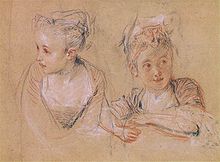Featured
- Get link
- X
- Other Apps
Technique
Technique
Almost all draftsmen use their hands and fingers to apply the media, with the exception of some handicapped individuals who draw with their mouth or feet.[27]
Prior to working on an image, the artist typically explores how various media work. They may try different drawing implements on practice sheets to determine value and texture, and how to apply the implement to produce various effects.
The artist's choice of drawing strokes affects the appearance of the image. Pen and ink drawings often use hatching – groups of parallel lines.[28] Cross-hatching uses hatching in two or more different directions to create a darker tone. Broken hatching, or lines with intermittent breaks, form lighter tones – and controlling the density of the breaks achieves a gradation of tone. Stippling uses dots to produce tone, texture and shade. Different textures can be achieved depending on the method used to build tone.[29]
Drawings in dry media often use similar techniques, though pencils and drawing sticks can achieve continuous variations in tone. Typically a drawing is filled in based on which hand the artist favors. A right-handed artist draws from left to right to avoid smearing the image. Erasers can remove unwanted lines, lighten tones, and clean up stray marks. In a sketch or outline drawing, lines drawn often follow the contour of the subject, creating depth by looking like shadows cast from a light in the artist's position.
Sometimes the artist leaves a section of the image untouched while filling in the remainder. The shape of the area to preserve can be painted with masking fluid or cut out of a frisket and applied to the drawing surface, protecting the surface from stray marks until the mask is removed.
Another method to preserve a section of the image is to apply a spray-on fixative to the surface. This holds loose material more firmly to the sheet and prevents it from smearing. However the fixative spray typically uses chemicals that can harm the respiratory system, so it should be employed in a well-ventilated area such as outdoors.
Another technique is subtractive drawing in which the drawing surface is covered with graphite or charcoal and then erased to make the image.[30]
You received this message because you are subscribed to the Google Groups "2top-manitotasy-3" group.
To unsubscribe from this group and stop receiving emails from it, send an email to 2top-manitotasy-3+unsubscribe@googlegroups.com.
To view this discussion on the web visit https://groups.google.com/d/msgid/2top-manitotasy-3/CADVsWigvX_-c7hwZgj3ddSw%3DCXbO6zev3qx59GtW4kD7Pgn_Eg%40mail.gmail.com.
- Get link
- X
- Other Apps


Comments
Post a Comment